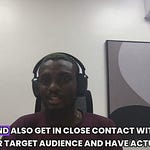Most businesses face the same problem: they depend too heavily on a few clients and lack a scalable way to grow. That was exactly the case with one of my software development clients in Mexico. Their revenue came almost entirely from two or three big corporate accounts. If even one left, half their business would vanish.
They had no database, no email list, and no consistent marketing. Just a few Instagram posts.
I needed to help them diversify, and quickly. The strategy I chose? A virtual summit.
Within five weeks, starting from zero, we went from no mailing list at all to 904 new subscribers and a three-day event with more than a dozen respected speakers - including a Mexican senator and the head of GS1 Mexico.
Here’s how it happened, and how you can replicate the process.
Why a Summit?
The idea came to me after studying two powerful examples:
The Traditional Skills Summit – launched by Darrell Vesterfelt and the School of Traditional Skills, this homesteading event drew 101,000 attendees and effectively launched their company.
The Hey Creator Summit – another Darrell Vesterfelt summit, was everywhere on LinkedIn for weeks, thanks to coordinated promotion by multiple influencers.
Both showed me the same principle: a virtual summit creates a “big splash” moment. It gives you:
A firm date that focuses all promotion.
A collaborative platform to pull in experts.
A scalable way to build an email list fast.
If “the money is in the list,” then a summit is one of the fastest ways to build one.
Step 1: Define the Category
You don’t just host an event - you declare a category. For my client, we planted a flag around “AI Smart Companies.”
The promise: helping small and medium-sized businesses use AI-powered software to become more agile and competitive.
That gave us a clear narrative and positioned my client not as “another outsourcing shop,” but as a thought leader creating a new category.
Step 2: Craft the Messaging and Design
Before inviting a single speaker, we needed messaging and visuals. Here’s what we did:
I drafted raw ideas into Claude (an AI tool), which returned polished copy for the event website.
Our in-house designer turned that into mockups - logos, taglines, and a conference page that made the summit feel real before it existed.
This early design was critical. It gave us a vision to rally around and made the summit “tangible” when pitching to partners and speakers.
Step 3: Recruit Bold Speakers
We built a list of 20 potential speakers - experts, influencers, and leaders our client already knew.
The key to speaker selection is twofold:
Expertise – they need authority in the topic.
Audience – ideally, they bring their own following.
We sent personalized invitations (again drafted with AI). To our surprise, all 20 said yes - including the senator and GS1’s country director.
This was the first lesson: boldness pays off. People are often more willing than you think to say yes when you invite them to something ambitious.
Step 4: Systematize Speaker Logistics
Getting “yes” is only half the battle. You also need bios, talk titles, headshots, and availability.
We built a Google Form that captured everything in one place. Submissions fed into a Google Sheet, which our web designer used to build the agenda and speaker pages.
This simple system cut down on endless back-and-forth emails and gave the summit structure.
Step 5: Use AI to Build the Agenda
With 16 confirmed speakers, scheduling was a nightmare. Some were only available certain days or times.
I uploaded the speaker sheet to Claude and asked it to generate a three-day agenda that accounted for:
45 minutes per talk
15 minutes of Q&A
Time-zone constraints
Claude produced a draft agenda in minutes, which we refined and published. What could have taken weeks was done in hours.
Step 6: Create Momentum with Content
To promote the event, I recorded interviews with the speakers on Riverside.fm. Each full interview generated:
A long-form YouTube video
4–7 short clips repurposed as YouTube Shorts, Instagram Reels, and LinkedIn posts
We published 74 videos in just a few weeks, overwhelming the feed with content tied to the summit.
This did two things:
Built early awareness (“What is this AI Smart Summit I keep seeing?”).
Gave speakers content they could share with their own audiences, multiplying reach.
Step 7: Leverage Partnerships
The breakthrough came when we partnered with CANACINTRA, Mexico’s largest manufacturing chamber of commerce.
We co-branded the summit with them, added their logo to our site, and they promoted the event across 32 regional chapters.
Other unexpected partners followed:
A Microsoft employee with a 3,500-subscriber newsletter promoted it.
An AI influencer with a big Instagram following shared it.
Entrepreneurs in WhatsApp groups spread it virally.
These alliances turned a small, scrappy summit into a national event.
Step 8: Engage the Audience Live
A summit isn’t just about registrations - it’s about keeping people engaged. We used interactive elements:
Raffles – attendees entered by typing hashtags in chat.
Two Truths and a Lie – even the senator played along.
Live quizzes – with small prizes for correct answers.
These touches kept people logged in from the first session to the last.
The Results
904 registrations
194 live attendees at peak (dropping to ~60 by day three, which is normal for free events)
A brand-new mailing list from scratch
Strong relationships with high-profile partners and influencers
And most importantly: my client is no longer dependent on two or three accounts. They now have a pipeline.
Lessons Learned
Category First – Don’t run a generic summit. Define a bold, new category.
Design Early – Professional mockups make an idea real.
Bold Invitations – People will say yes if your vision is ambitious enough.
AI is a Force Multiplier – From website copy to scheduling, AI made five weeks possible.
Partnerships Beat Ads – Chambers of commerce, newsletters, and influencers delivered far more registrations than paid ads could have (and at zero cost).
Final Thought
A virtual summit is one of the fastest ways to go from invisible to category leader. It’s not easy - wrangling speakers is like herding cats, and tech hiccups will happen - but the rewards are transformational.
If you want to make a splash, launch a new category, and build an email list from zero, there may be no better tool.
The only real question is: What bold category will you design your summit around?











